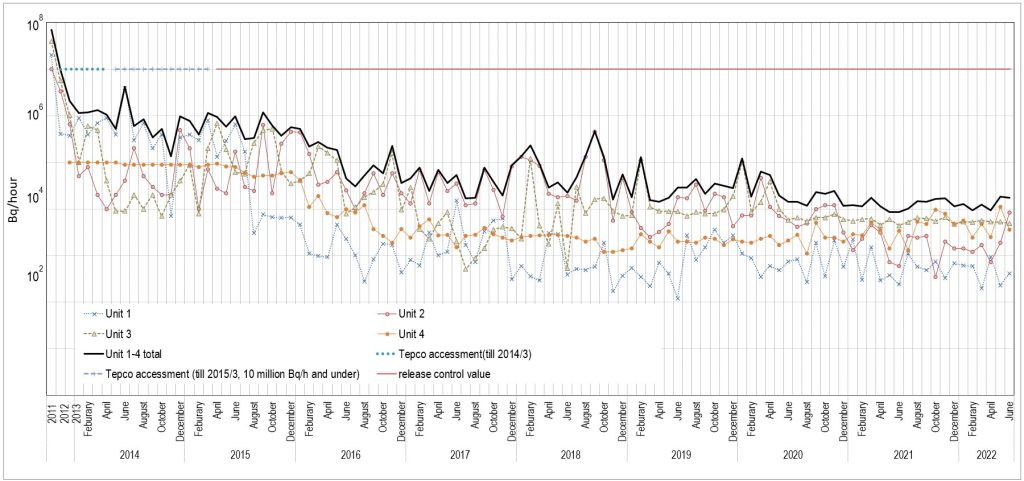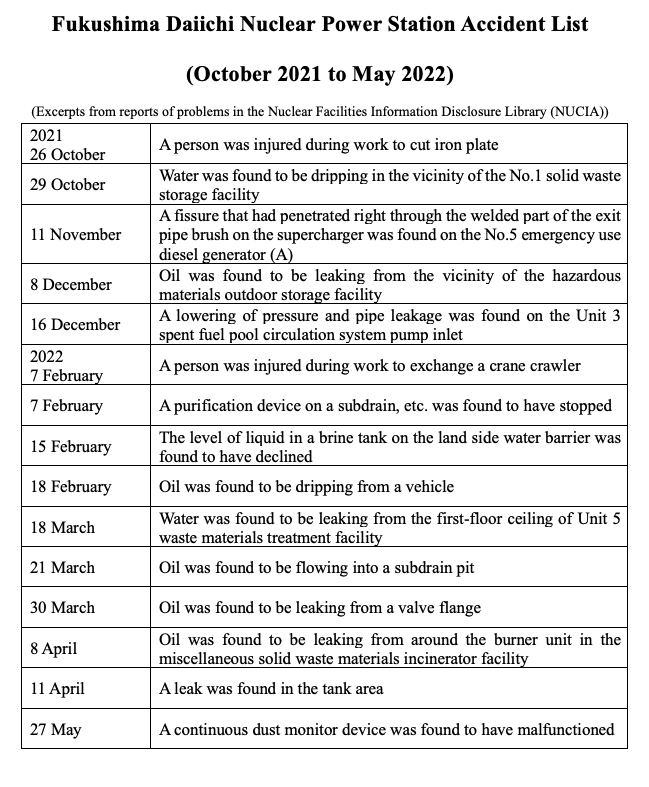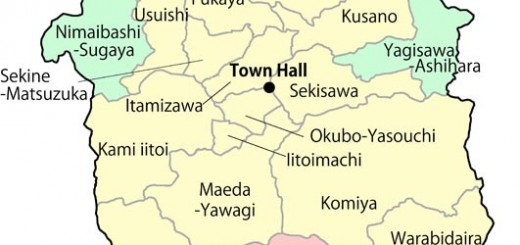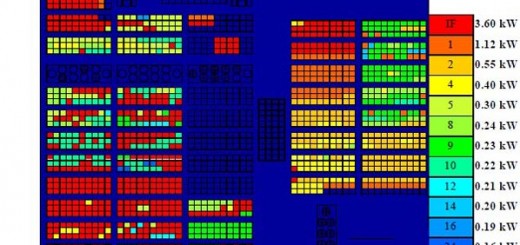Fukushima Now Part 2: Current State of Post-Accident Operations at Fukushima Daiichi Nuclear Power Station (Jan. to Jun. 2022)
By Matsukubo Hajime (CNIC)
State of the Plant
The water temperature in the containment vessels and the spent fuel pools (SFPs) varies mostly around less than 35oC and no great changes have been seen. The state of releases of Xenon-135 (half-life roughly nine hours), released when uranium fuel undergoes fission is also unchanged and it can therefore be estimated that the state of the reactors is stable. Further, according to an assessment by TEPCO in June 2022, around 17,000 becquerels per hour (Bq/h) of radioactive materials were being released to the atmosphere from the buildings (Fig.1).
Fig. 1. Radioactivity from Units 1 to 4 of Fukushima Daiichi Nuclear Power Station (Bq/h) released to the air
At the same time, decay heat has fallen greatly with the passage of time, and thus the volume of cooling water injected into the reactors has been reduced (falling from 7-10m3 per hour in May 2011 to 1.5-2.1m3 per hour as of June 2022).
The state of removal of spent nuclear fuel from the SFPs is summarized in Table 1. Spent nuclear fuel removal from Units 4 and 3 has been completed. However, as it has not been possible to remove control rods and other high-dose equipment stored in the SFPs, preparatory work is underway for removal of this equipment from Unit 3 in the second half of FY2022 and from Unit 4 in the second half of FY2024. Units 1 and 2 are being prepared for spent nuclear fuel removal.
Preparations for the removal of fuel debris are also under way. The arrival of the device for removing debris from Unit 2, developed in the UK, was delayed due to the spread of the coronavirus and finally arrived at the Naraha mockup facility in Japan in February. Removal tests are scheduled to be conducted during 2022. Plans are underway for an internal investigation device to be inserted into Unit 1 reactor pressure containment vessel (PCV), and also to withdraw water in two stages from the Unit 3 PCV and suppression chamber due to a water level drop.
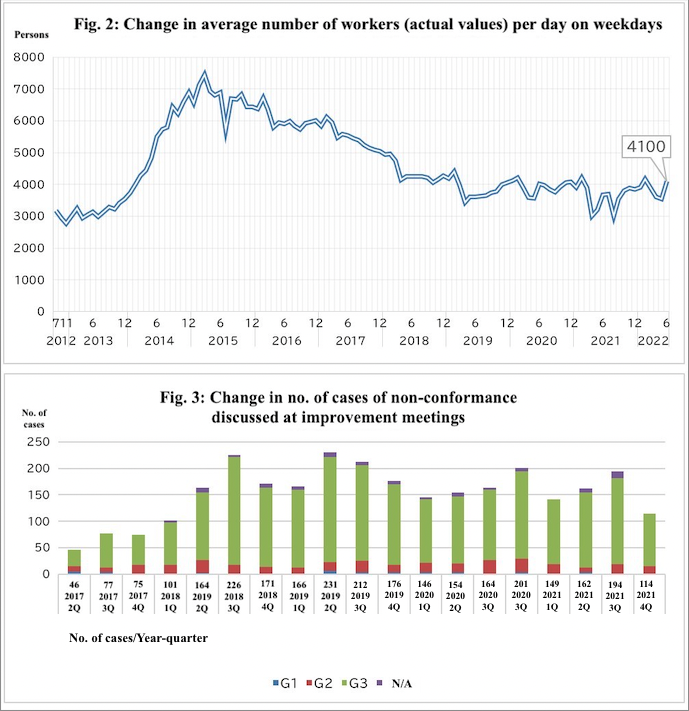 The changes in the average number of workers onsite per day is shown in Fig. 2. As of June 2022, the number of workers was 4,100, about half the number it was at its peak. Changes in the number of cases of work non-conformance (work states that differ from the states originally intended or acts or judgments that differ from those that should have been taken) up to March 2022 are shown in Fig.3, as reported on the TEPCO website. As ever, problems appear to occur frequently, and this attests to the severe conditions under which work is being carried out at the site.
The changes in the average number of workers onsite per day is shown in Fig. 2. As of June 2022, the number of workers was 4,100, about half the number it was at its peak. Changes in the number of cases of work non-conformance (work states that differ from the states originally intended or acts or judgments that differ from those that should have been taken) up to March 2022 are shown in Fig.3, as reported on the TEPCO website. As ever, problems appear to occur frequently, and this attests to the severe conditions under which work is being carried out at the site.
State of Contaminated Water
Contaminated water countermeasures at FDNPS can be broadly divided into three areas: 1) Reduction of groundwater flowing into buildings, 2) Reduction of contaminated water flowing into the sea, and 3) Reduction of the toxicity of contaminated water. The main countermeasures to reduce water inflow into the buildings are, from higher elevations downward, (A) Pumping up groundwater at the groundwater bypass and releasing it into the sea (754,521m3 up to August 22, 2022), B) Installation of a frozen earth barrier (on-land water barrier, total length roughly 1,500m) surrounding FDNPS Units 1-4. C) Pumping up water at the subdrains and releasing it into the sea (1,365,094m3 up to August 22), and D) Paving of the site with asphalt to suppress permeation of rainwater into the soil. Measures to prevent the discharge of contaminated water into the ocean include A) Groundwater leakage prevention by a steel water barrier on the sea side, B) Pumping up of groundwater dammed up behind the sea-side water barrier from the well points and groundwater drains (roughly 278,000m3 up to August 3; highly contaminated groundwater is being transferred to the turbine building), and other measures.
To reduce the toxicity of contaminated water, after removal of cesium and strontium, and removal of impurities using a reverse osmosis (RO) membrane, radionuclides other than tritium are removed by the multi-radionuclide removal equipment (ALPS – Advanced Liquid Processing System) and then stored in tanks (containing 1,310,518m3 as of August 4. However, due to past equipment malfunctions and operational policies, in many cases radionuclides other than tritium are also present, resulting in only around 32% of the stored water being below the notification concentration). Besides this, roughly 12,660m3 water remain in buildings, as well as 10,634m3 strontium-treated water, etc., 7,605m3 water treated by RO, 100m3 concentrated brine, and 9,280m3 concentrated wastewater etc. also existing onsite.
The frozen earth barrier consists of about 1600 freeze pipes buried in the ground. The freeze pipes are each 30 meters long and -30°C coolant is circulated through them to freeze the surrounding soil. The effectiveness of the frozen earth barrier has been questioned since it was first installed, but since 2019 there have been several coolant leakage incidents. This is due not to the technology but to aging of the equipment, which was originally not intended for long-term operation.
Concerning TEPCO’s policy of releasing contaminated water into the ocean after ALPS treatment, the policy to release the water was authorized at the 25th Meeting of the Nuclear Regulatory Authority on July 22, and the construction was approved by the governor of Fukushima Prefecture and the mayors of both Okuma Town and Futaba Town in August. TEPCO is aiming to begin releases next spring, but fishery-related people are as ever opposed to the oceanic releases.
